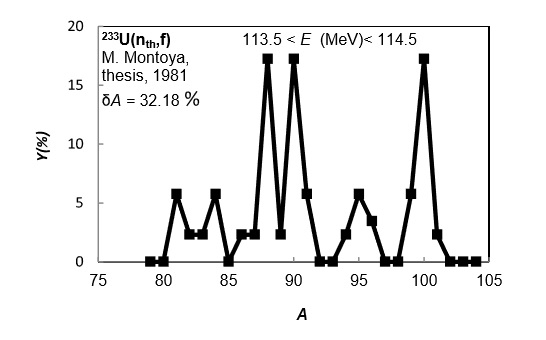Ruptura de parejas y efectos coulombianos en la fisión fría de las reacciones 233U(nth, f), 235U(nth, f) y 239PU(nth, f) Pair breaking and coulomb effects in cold fission reactions from 233U(nth, f), 235U(nth, f) y 239PU(nth, f) Modesto Montoya
DOI:
https://doi.org/10.33017/RevECIPeru2012.0014/Keywords:
uranium 233 235 plutonium 239 cold fission.Abstract
This paper shows pair breaking and electrostatic (Coulomb) interaction effects on the distribution of mass and kinetic energy in cold fission of 233U, 235U and 239Pu thermal neutron induced. The fission process ends at the scission point, when the complementary fragments 1 and 2, having masses y are formed. Then those fragments goes away each other and acquire kinetic energies y , reaching the detectors after emission of y neutrons, having masses and kinetic energies, respectively. As a result, in regions where the average of varies abruptly as function of , the distribution of will be wider than it was for the distribution of as a function of . Furthermore, the emission of neutrons erodes odd-even effects on the distribution of neutron number, defined as the difference between the relatives yields of fragments with even and odd, respectively. Neutron emission, consequently, also erodes the odd-even effect on the mass distribution of the fragments. To avoid these disturbances, cold fission, i.e. with no neutron emission, is studied. Windows with total kinetic energy close to the maximum available energy, corresponding to low total excitation energy, are selected. Contrary to expected, for that excitation energy region, a weak even-odd effect is observed. This result is not incompatible with a strong odd-even effect on the charge distribution or neutron number distribution. Moreover, in cold fission, the minimum value of total excitation energy, as a function of , is correlated with the "Coulomb energy excess" defined as the difference between the energy electrostatic interaction of the complementary fragments (assumed spherical) in the scission point and the available energy of the reaction. This also explains correlation fluctuations in the maximum kinetic energy as a function of the mass. This effect increases with the asymmetry of the charge fragmentations. In sum, the experimental data on cold fission suggest that scission configurations explore all the possibilities available energy for fission.


